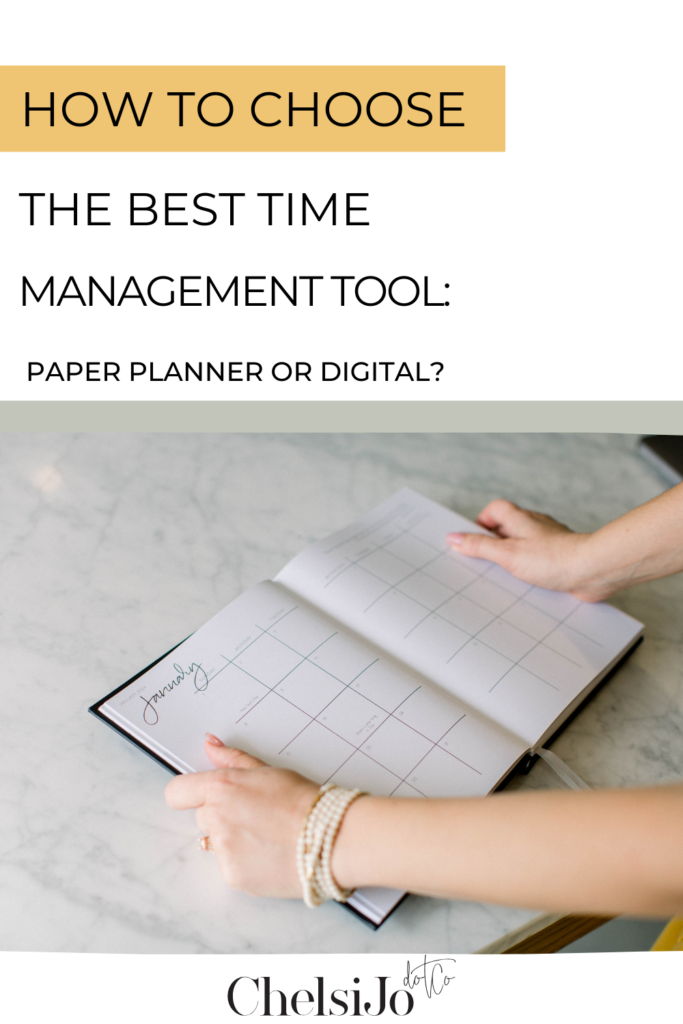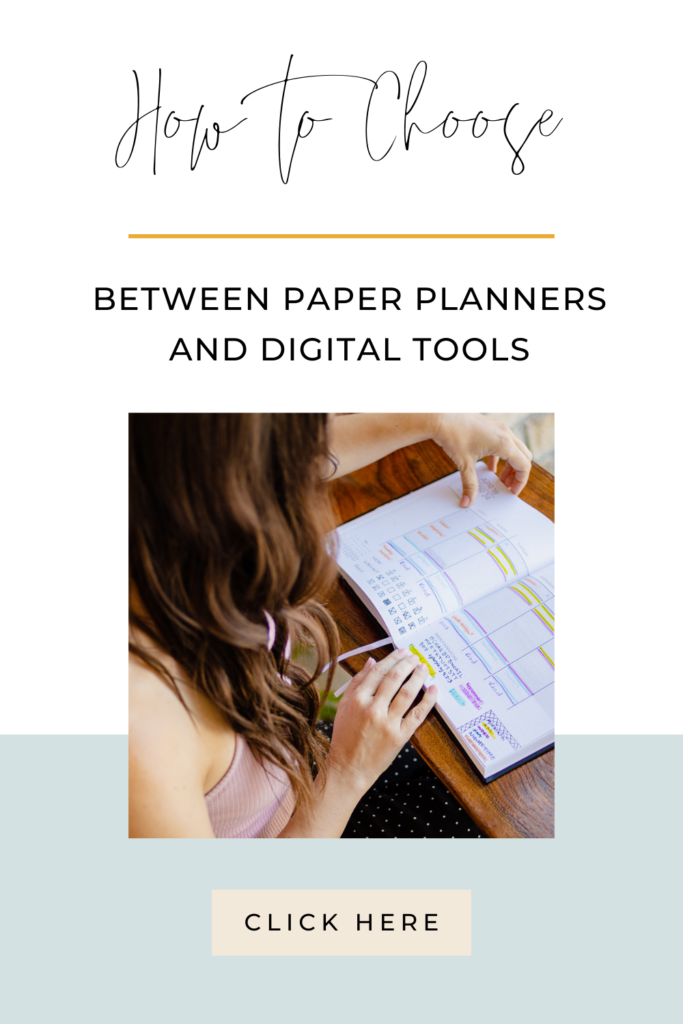Have you ever Googled “Paper Planner vs. Google Calendar”? I’m thrilled to present a fresh pros and cons list for you. Although I have my personal preferences, I want you to know that I teach a hybrid method. Of course, using Google Calendar to manage our time is essential, but let’s dive deep into the pros and cons of each option to help you decide what’s best for you.
I lean towards using a paper planner over a purely digital approach. It’s not just about choosing between paper and digital tools; it’s about having a system that you actually use. Selecting the right tool to manage your system is crucial. I believe that opting for a paper planner can set you up for greater success. Let’s discuss the pros and cons.
“It’s not just about choosing between paper and digital tools; it’s about having a system that you actually use.”
Listen Below For The Entire Episode On The Systemize Your Life Podcast
Pros And Cons Of Using Your Phone For Time Management
First, let’s explore the pros and cons of using your phone for time management. Instead of focusing on a specific app, we’re going to compare paper planners to digital tools in general. There are countless paper planners and numerous time management apps and software options available. So, let’s consider the basic comparison between paper and digital tools.
One of the major pros of managing your time on your phone is its portability. You can take your phone anywhere you go, and it’s always with you, super compact, and much smaller than carrying around a paper planner. This is a significant advantage.
Pro #2: Integration
Another significant advantage is integration. Your phone can sync with everything, allowing you to share your calendar and to-do lists with others in your household, like your spouse or older kids. This feature ensures that you can access and update your schedule and tasks no matter where you are. This seamless synchronization is a major benefit and one of the reasons I advocate for a hybrid method.
Pro #3: Customization And Personalization With Digital Time Management Tools
The third pro is the ability to customize and personalize everything. With many calendar apps, you can tailor notifications, automate repeating tasks, and set specific start and stop times. This level of customization is incredibly helpful. Additionally, you can switch between different apps, like a simple checklist app, Reminders app, and Google Calendar. This adaptability allows you to optimize each part of your time management system, leveraging the strengths of different apps.
Pro #4: The Convenience And Drawbacks Of Reminders In Digital Time Management
Number four, this one’s really cool. One of the biggest perks is that you can get reminders and alerts. I can tell Siri to remind me of things at any given moment, which is very convenient. However, before we move on to the cons, I want to emphasize that this can become a major crutch. That’s why I mentioned earlier that this is a band-aid solution. People often tell me they rely on reminders because they have to remember everything. This reliance happens because you’re holding everything in your head, necessitating constant reminders. Without a clear, flexible, and repeatable time management system, you end up needing constant alerts to manage your tasks.
I’m about to turn 41, and I find myself needing far more reminders and alerts than I did when I was younger. My bandwidth is at max capacity, but I’m okay with that because I’m pushing myself in every area of my life. Even though I’m managing a lot, I still find it necessary to rely on these tools to keep everything running smoothly.
Pro #5: Efficiency In Digital Tools
The fifth pro of using a phone or something digital for your time management is its sheer efficiency. It’s incredibly quick and handy; you can find and jot down information swiftly since it’s always in your hand and readily available. Depending on how sophisticated you want to get, you can prioritize tasks, collaborate with others, and even include family members and babysitters. This level of integration and utility can be really cool and highly beneficial.
Distractions: The Major Downside Of Using Your Phone For Time Management
Let’s talk about the cons. The number one con says it all. The major downside is the distractions. Your phone is a source of addiction, constant notifications, and multitasking, making it incredibly easy to get distracted. This is why I firmly believe that home management should be as digital and tech-free as possible, with the notable exception of the Google Calendar. I know this might seem contradictory since Google Calendar is on your phone, but bear with me.
Yes, but that’s where we put our events and places we need to be. It’s not about managing all of our time from the moment we wake up until we go to bed. Time management isn’t about scheduling appointments for yourself all day; that’s schedule management. We don’t want to be on a strict schedule every day because it can feel very rigid. When something goes wrong, the entire schedule gets disrupted.
So, back to number one, I’ll emphasize this again and again: having your phone in your hand all day long and trying to get things accomplished is a major distraction.
Con #2: The Dependency On Battery Life
Number two, this one is funny to me, but your phone has to be charged, and you have to know where it is at all times. Being dependent on your phone and always needing to ensure it’s charged is a real issue. While it’s not a major game changer in my life anymore since I don’t use my phone as much, I remember when it was a significant concern. Nowadays, when I need to do something digital, I mostly use my laptop, not my phone.
This may seem like a minor issue, but it’s a big deal when you’re trying to manage your entire life from your phone and it’s always almost dead or you have to make sure it’s nearby and ready. I can’t even count the times I’ve sat down to do something and realized my phone’s almost dead. It’s super frustrating. So there’s a clear dependency on battery life, something a paper planner doesn’t require.
Con #3: The Pitfalls Of Over-Reliance On Technology for Time Management
Number three is over-reliance on technology. This is a huge con. Being 100% sucked into the vortex of our phones is terrible. There will always be issues with it—whether it’s an update, a dead battery, a cracked screen, or other technical problems. It’s more about the dependency on this device.
I talk about this a lot. There is an entire world happening inside your phone that no one else in your actual life knows anything about. Your happiness, sadness, productivity, sense of accomplishment, and self-worth can all be tied to this little digital box. We need to be very careful about that. Relying on technology to help you live your real life—with your hands, feet, eye contact, heart, and voice—can be risky. Any opportunity to be pulled out of that little black box, I will take.
Con #4: The Complexity Of Digital Tools For Time Management
The fourth con is that I believe it’s too complicated. There are so many options available that it can be overwhelming. You might not know where to start, so you don’t, or you try it and it doesn’t work. While digital tools are technically customizable, the sheer complexity can make them feel anything but. It’s difficult to tailor them to fit your life perfectly. Instead, you often find yourself trying to adapt to the app or software, rather than it adapting to you. This lack of true customization is a significant issue for me.
Con #5: The Potential Costs Of Digital Tools For Time Management
The fifth con is the potential cost. While there are costs associated with paper planners, digital apps often come with hidden expenses. You might purchase a tool or resource thinking it will be helpful, only to discover upgrades and additional subscriptions are needed. If the tool truly solves your problems, it might be worth considering, but do we really need another monthly subscription? Digital tools are designed to generate profit. Yes, you need to buy a new paper planner every year, but that’s expected. Sometimes you might find a free app or tool that works for you, which is great, but it’s not always the case.
I know from personal experience that the fancy displays available now are incredibly intriguing. I’m even considering buying one just to review its impact on my time management and home management system. Based on my past experiences and observations of others trying to manage everything digitally, I have a sneaky suspicion about the outcome. I’ve seen how digital-only management can unfold, and I’m curious to see if my predictions hold true.
The Tangibility And Focus Of A Paper Planner
Let’s jump into the pros and cons of managing your time with a paper planner. Starting with the pros list, number one is its tangibility. It’s right here, a physical object you can see, touch, and even smell. This physical presence significantly impacts memory retention and engagement. It connects what’s happening in your brain to what you’re actually doing. A paper planner keeps you focused and undistracted because there’s nothing to scroll through and no notifications popping up. This is the primary reason I encourage people to use a paper planner, and it’s why I still use one myself.
Pro #2: The Customizability Of Paper Planners
Number two, it is completely customizable, 100% of the time. You can even go the bullet journal route if you want to, and fully customize it—especially if you don’t have kids, have a lot of time on your hands, or are really good at doodling and drawing. Bullet journaling can be incredibly therapeutic and cathartic. I highly recommend it if you enjoy creating your own planner from scratch. You can buy a simple journal or one with grid paper and create a bullet journal that fits your needs perfectly. It’s a beautiful process, though it can be a bit distracting unless this is your niche and you love to doodle. Sometimes, I get so caught up in creating that I forget to actually plan!
But even with other planners, you can still find options that are highly customizable. That’s why I love the Horatio Printing Dream Planner so much. It offers a clean, uncluttered layout that allows you to tailor it to your specific needs. It’s versatile and doesn’t overwhelm you with too much pre-filled information, making it easy to personalize.
Pro #3: Focus And Mindfulness With A Paper Planner
The third pro is your focus and ability to be present, essentially mindfulness. There’s a unique connection between your brain and hand when you write things down. This reflective process is crucial, especially if you’re managing a household and juggling countless tasks. Reflecting on what did or didn’t work is vital for planning the week ahead. When you’re just clicking digital items, this level of reflection often doesn’t occur because your brain doesn’t have the same bandwidth to process it. Writing things down fosters this necessary reflection, which is why I always lean towards using a paper planner.
Also, under this umbrella, I noted how using a paper planner reduces screen time. While we don’t need to delve deeply into this, it’s clear that by planning on paper, you’ll pull yourself away from your screen for at least an hour or two on the weekends when setting up your week. Additionally, you’ll be checking your planner daily instead of constantly checking your phone, which is a significant benefit.
Pro #4: Reliability With A Paper Planner
Number four is reliability. There’s no need to worry about battery life—your paper planner is always ready whenever you need it, unless you forget it. There are no tech issues to deal with either. Even if your kids draw all over it, it will still work. The planners I use are extremely sturdy and durable. I take mine everywhere, toss it around, and it still looks great all year long.
Pro #5: Flexibility Of A Paper Planner
Number five is the flexibility of a paper planner. Beyond customization, the true flexibility lies in adapting any planner to fit your needs at home. You can take what you need to accomplish and seamlessly integrate it into a paper planner. My home management system works exceptionally well in planners where the days run from top to bottom and the week spans from left to right, but I’ve seen people use other layouts effectively too. The key difference is that paper planners can be adapted in ways that digital tools sometimes can’t.
Cons #1: Paper Planner Portability Issues
Let’s quickly go over the cons. If you have any thoughts or want to discuss this further, feel free to join our free Facebook group. That’s where we gather to talk about podcast topics and share experiences. Connect with thousands of other women who are listening and working on implementing systems in their lives.
The biggest con is that a paper planner isn’t very portable. Who wants to lug around a paper planner and say, “Oh, let me check my calendar”? I remember those days before digital calendars were a thing. When I first started interpreting in my early 20s, I’d have to pull over, pause a phone call, and flip through my paper planner to check my availability. We’re not doing that anymore, and I don’t recommend it. That’s why we keep our schedules in our Google Calendar.
Con #2: Manual Entry And Lack Of Reminders In Paper Planners
Number two, everything requires manual entry. There’s no way to set up recurring tasks, which I hear as a frequent complaint. While I believe there’s value in writing things down each week, it does mean you have to do it manually every time. Additionally, there’s no reminder system with a paper planner. If you need a reminder to pull the meat out of the fridge at 2 PM, your paper planner isn’t going to text you. That’s definitely a downside.
Con #3: Lack Of Integrations And Backup In Paper Planners
Number three is the lack of integrations. Unlike digital software, a paper planner doesn’t sync with your Google Calendar. You have to manually enter events into both, which can be time-consuming. Additionally, there’s no backup for your planner. If something happens to it, all your information is lost.
Con #4: Bulkiness And Limited Space In Paper Planners
Number four, it’s bulky. A paper planner can be quite large, making it cumbersome to carry around, especially if you already have a lot in your hands or need to fit it into a purse. Additionally, there’s limited space to write or type information. You can only fit so much on the pages. That’s why I highly recommend creating a system inside your paper planner that guides your intentions and time rather than just jotting down schedules and to-do lists. This way, you make the most of the available space and focus on what truly matters.
Con #5: Cost Considerations Of High-Quality Paper Planners
Number five. This can be a limitation for some people, and it’s the cost of the planner. You already have a phone, so why not just use what’s free in there? There are planners that cost $3, $4, or $5, and you can even find some at the dollar store that would work. However, the paper planners I recommend, and most high-quality ones, can be quite costly. Some range from $40 to $75 each year. For me, the sanity, time saved, the ability to generate income in my business, and showing up fully for my family make it worth every penny.
Wrapping It Up…
I hope you’ve enjoyed our discussion on paper planners versus digital tools and the unique benefits of each for time management. Ultimately, the choice will depend on your personal preferences, lifestyle, and specific needs. However, I hope you’ll consider the direction I’ve been steering you towards.
If you do end up putting any of these tips into place, I’d love for you to share them within our vibrant Facebook community or come over and visit me on Instagram. Not only will it serve as a piece of accountability for you, but it will also encourage other moms who haven’t yet taken action on what they’ve read. And remember that we would LOVE to see you inside of Systemize Your Life as a VIP student!
Thanks so much for being here with me!


Frequently Asked Questions
Is a paper planner, in this digital age, really that worth it?
Here are some other ways you can dig in to discover if this is right for you. Check out some other similar blog posts that can be helpful like: How to Reduce Stress as a Busy Mom by Using a Paper Planner or 5 Tips on How To Use Your Paper Planner.


